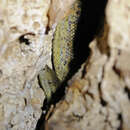en
names in breadcrumbs


The Jamaican boa',[4]Jamaican yellow boa or yellow snake[5] (Chilabothrus subflavus; in Jamaican Patois: nanka)[6] is a boa species endemic to Jamaica. No subspecies are recognized.[4] Like all other boas, it is not venomous.
The Jamaican boa is golden-green around the head and along the anterior section of the body, with black zigzag crossbars, becoming black toward the posterior end of its body. The snake's body is quite long, up to 2 metres (6 feet 7 inches) in total length.
Found in Jamaica in the Cockpit Country, including Goat Island. The type locality given is "Jamaica".[3] It lives in moist limestone forests.
The Jamaican boa's natural populations greatly and constantly declined since the late 19th century, mainly because of predation by introduced species (such as mongooses), human persecution, and habitat destruction. In-situ conservation of the Jamaican boa is seriously hindered by the lack of information on demographic and ecological parameters as well as by a poor understanding of the population structure and species distribution in the wild. This species is classified as Vulnerable (VU) on the IUCN Red List of Threatened Species with the following criteria: A2ce (v2.3, 1994).[7] A species is listed as such when the best available evidence indicates that a population decline of 20% is expected within the next ten years or three generations, whichever is the longer, due to a decline in the quality and area of occupancy. It is therefore considered to be facing a high risk of extinction in the wild. Year assessed: 1996.[8]
Their natural habitat is being destroyed, which is forcing them into inhabited areas, where they are captured and killed. Some measures have been taken to afford these animals some protection:
The Jamaican boa',Jamaican yellow boa or yellow snake (Chilabothrus subflavus; in Jamaican Patois: nanka) is a boa species endemic to Jamaica. No subspecies are recognized. Like all other boas, it is not venomous.